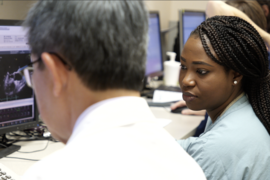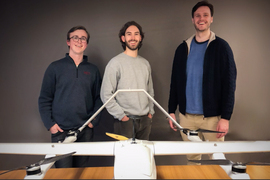Five years ago, what began as three nervous Norwegians spotting each other across a study room has evolved into a drone company enabling sustainable deliveries, elder care, and more against a backdrop of unforgiving conditions.
Lars Erik Fagernæs, Herman Øie Kolden, and Bernhard Paus Græsdal all attended the Norwegian University of Science and Technology, but their paths first crossed in the MIT Professional Education Advanced Study Program lounge in 2019, while they were apprehensive about their impending English exam. From there, they each pursued different tracks of study through the Advanced Study Program: Fagernæs studied computer science, Kolden took applied physics classes, and Græsdal, robotics. Months later, when the world shut down due to the Covid-19 pandemic, the trio’s professional trajectories intertwined.
At the height of the pandemic in 2020, Fagernæs, Kolden, and Græsdal launched Aviant — a drone delivery service company. Aviant flew blood samples across Norway’s vast countryside to assist remote hospitals in diagnosing Covid. Today, their drones are delivering groceries, over-the-counter medicines, and takeout food to populations outside city centers.
Capitalizing on momentum
The pandemic waned, but the need for medical sample delivery did not. Remote hospitals still require reliable and rapid sample transportation, which Aviant continues to supply through its commercial contracts. In 2021, instead of sticking with commercial-only deliveries, the Aviant founders decided to use their momentum to reach for the largest market within autonomous transportation: last-mile delivery.
“Yes, you need a higher volume for the business case to make sense,” explains Fagernæs of the expansion. “Yes, it is a lot more risky, but if you make it, it’s such a big opportunity.” The Norwegian government and various venture capital firms backing Aviant agree that this risk was worth their investment. Aviant has secured millions in funding to explore the consumer market through its newest offering, Kyte.
To scale operations, work still needs to be done to ingratiate drone delivery to the general population. Emphasizing the environmental benefits of aerial versus traditional road deliveries, the founders say, may be the most compelling factors that propel drones to the mainstream.
So far, Aviant has flown more than 30,000 kilometers, saving 4,440 kilograms of carbon dioxide that would have been emitted through traditional transportation methods. “It doesn’t make sense to use a two- to four-ton vehicle to transport one kilogram or two kilograms of sushi or medicine,” Fagernæs reasons. “You also have cars eroding the roads, you have a lot of car accidents. Not only do you remove the cars from roads by flying [deliveries] with drones, it’s also a lot more energy efficient.”
Aviant’s competitors — among them Alphabet — are spurring Fagernæs and Kolden to further improve their nicknamed “Viking drones.” Designed to sustain Norway’s harsh winter conditions and high winds, Aviant drones are well-adapted to service remote areas across Europe and the United States, a market they hope to break into soon.
The unmatched MIT work ethic
Fagernæs and Kolden owe much to MIT: It’s where they met and hatched their company. After his time with the Advanced Study Program, Græsdal decided to return to MIT to pursue his doctorate. The professors and mentors they engaged with across the Institute were instrumental in getting Aviant off the ground.
Fagernæs recalls the beginning stages of discovering the drones’ theoretical flying limit; however, he quickly ran into the hurdle that neither he nor his peers had experience deriving such data. At that moment, there was perhaps no better place on Earth to be. “We figured, OK, we’re at MIT, we might as well just ask someone.” Fagernæs started knocking on doors and was eventually pointed in the direction of Professor Mark Drela’s office.
“I remember meeting Mark. Very, very humble guy, just talking to me like ‘Lars, yes, this, I will help you out, read this book, look at this paper.’” It was only when Fagernæs met back up with Kolden and Græsdal that he realized he had asked elementary questions to one of the leading experts in aeronautical engineering, and he truly appreciated Drela’s patience and helpfulness. The trio also credit Professor Russ Tedrake as being an inspiration to their current careers.
Additionally, the work ethic of their fellow Beavers inspires them to work hard to this day. “I was finishing an assignment, and I think I left the Strata Student Center at 5:30 [in the morning] and it was half-full,” Kolden remembers. “And that has really stuck with me. And even when we run Aviant now, we know that in order to succeed, you have to work really, really hard.”
“I’m impressed with how much Aviant has accomplished in such a short time,” says Drela. “Introducing drones to a wider population is going to make large improvements in high-value and time-critical payload delivery, and at much lower costs than the current alternatives. I’m looking forward to seeing how Aviant grows in the next few years.”
“For the betterment of humankind”
Drones are the future, and Kolden is proud that Aviant’s electric drones are setting a sustainable precedent. “We had the choice to use gasoline drones. It was very tempting, because they can fly 10 times farther if you just use gasoline. But we just came from MIT, we worked on climate-related problems. We just couldn’t look ourselves in the mirror if we used gasoline-driven drones. So, we chose to go for the electric path, and that’s now paid off.”
In the age of automation and perceived diminishing human connections, Kolden did have a moment of doubt about whether drones were part of the dilemma. “Are we creating a dystopian society where my grandfather is just meeting a robot, saying, ‘Here is your food,’ and then flying off again?” Kolden asked himself. After deep conversations with industry experts, and considering the low birth rate and aging population in Norway, he now concludes that drones are part of the solution. “Drones are going to help out a lot and actually make it possible to take care of all people and give them food and medicine when there simply aren’t enough people to do it.”
Fagernæs also takes to heart the section of the MIT mission where students are urged to “work wisely, creatively, and effectively for the betterment of humankind.” He says, “When we started the company, it was all about using drones to help out society. We started to fly during the Covid pandemic to improve the logistics of the health-care sector in Norway, where people weren’t being diagnosed for Covid because of lacking logistics.”
“The story of the success of Lars Erik, Herman, and Aviant makes us proud of what we do at MIT Professional Education.” says Executive Director Bhaskar Pant. “Share MIT knowledge that leads people to be innovative, entrepreneurial, and above all pursue the MIT mission of working toward the betterment of humankind. Kyte is a shining example of that.”
Drone company founders with MIT Advanced Study Program roots seek to bring aerial delivery to the mainstream.
Publication Date:
Press Contact:
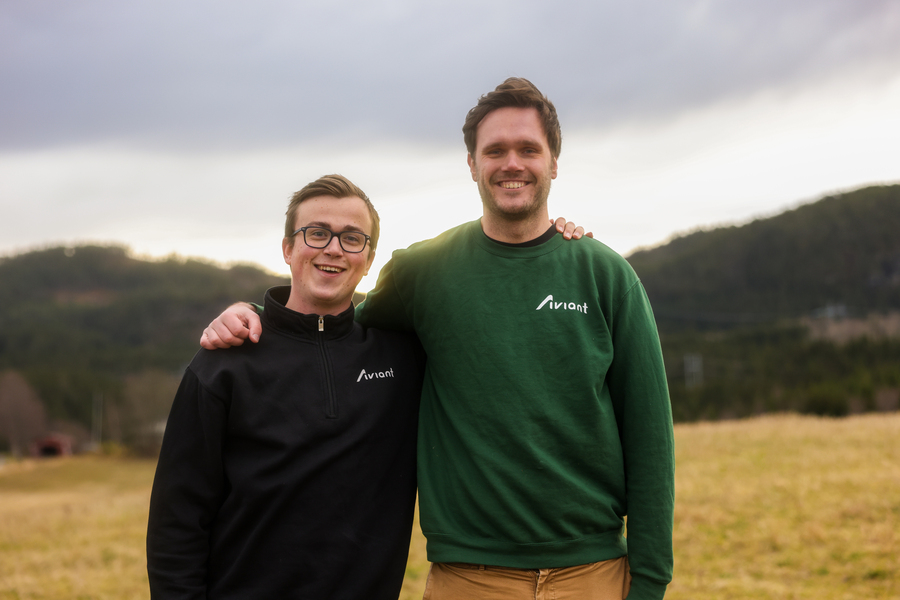
Caption:
Former students in the MIT Advanced Study Program Herman Øie Kolden (left) and Lars Erik Fagernæs expanded their drone company, delivering essentials and peace of mind to remote communities.
Credits:
Photo: Axel Brandtzaeg
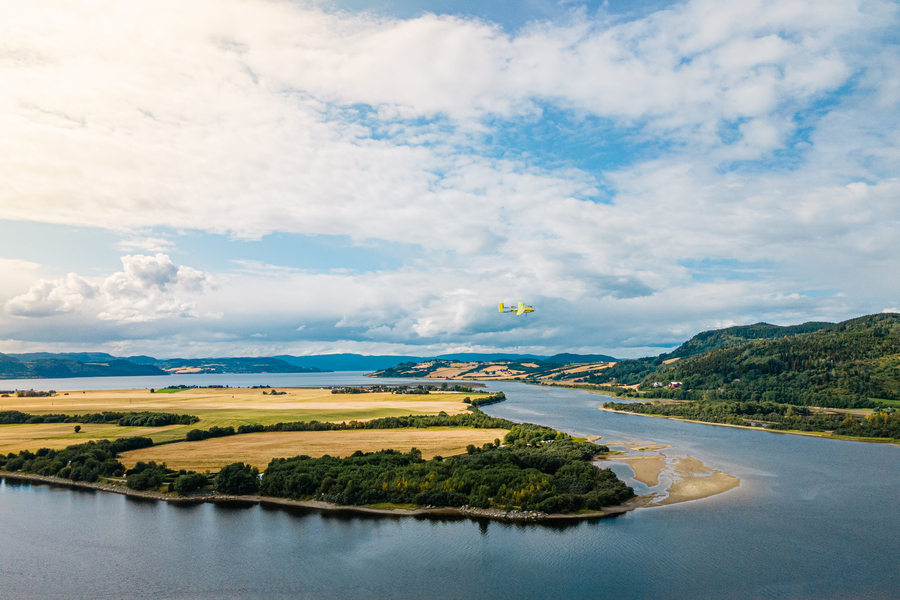
Caption:
Aviant drone flies over Scandinavian wilderness
Credits:
Photo: Otto Johnsen
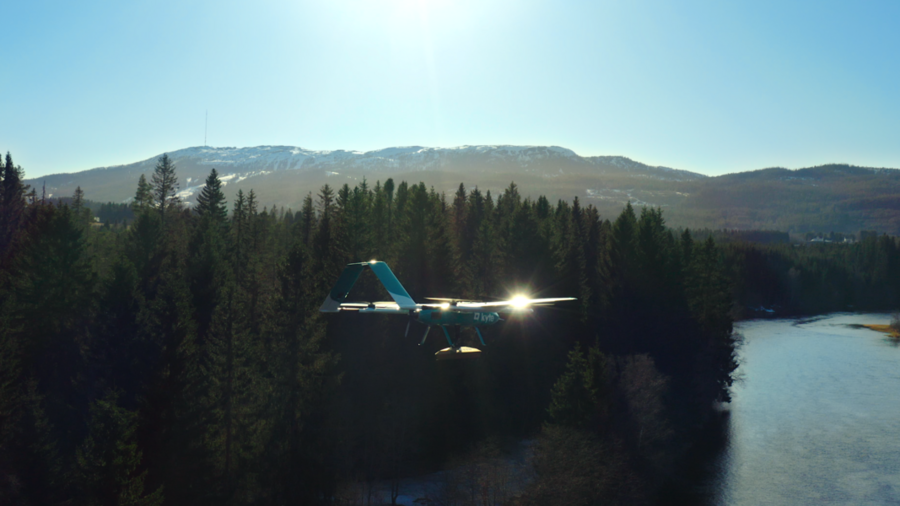
Caption:
Kyte drone out for delivery in the wilderness
Credits:
Photo courtesy of Aviant.
Related Topics
Related Articles

